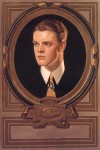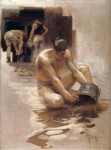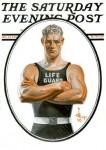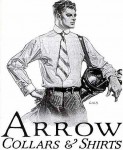I don’t know how long I’ve been waiting for a book dedicated to J.C. Leyendecker’s life and work, or more exactly, one that doesn’t hide the artist’s gayness and gay appeal. More than a decade, that’s for sure.
Joseph Christian Leyendecker (1874-1951) was one of the most famous and important commercial illustrators in the USA during the first half of the XXth century. Nowadays, someone like Norman Rockwell, who admired him (and was rather inspired by him at first), is far more famous. In fact, I first heard of Leyendecker through Steve Rude, a comic book artist, whose painted covers were sometimes influenced by Leyendecker. And then, I learned Leyendecker was gay, although completely in the closet for the public during his life. In gay art history books, he was cited as having used his lover, Charles Beach, as a model for his most famous creation, the Arrow Collar Man.
This new, 256-page art book (available from Amazon), written by Judy and Laurence Cutler, tries to offer a contextualized view of Leyendecker’s long and fruitful career in the commercial art world. It opens with a short history of American illustration up to Leyendecker’s appearance, and then gives us a biographical sketch, which uses what little is known about the artist’s life–his private papers were destroyed by his partner when he died, at his request (that was during McCarthyism, a period not known for its openness toward gay people). Leyendecker, whose star was rising, met Beach in 1903, when the very handsome (and 17-year old) Beach was looking for modeling jobs. He found one, and more, since the two men spent the rest of their lives together, with Beach surviving his partner by only a short time.
The writers of the book seem to me to have a balanced view of the relationship, and aren’t trying to present it as a model of gay love (if there is such a thing), while stating that it had been long known by gay fans that Leyendecker and Beach had had a long relationship. In fact, they do their best to acknowledge the importance of a gay following for Leyendecker’s posthumous fame, as well as the strong homoeroticism of a number of his works, for example with the group paintings showing multiple and ambiguous looking lines between the characters.
I only regret that there wasn’t room to include more of his drawings and paintings of half-naked athletes, although there are a lot in this book (among about 600 reproductions, from nine a page to double-page spreads).
I know I’ll be leafing through this book again and again. There are so many beautiful works that need to be stared at that this isn’t a book that should shelved any time soon.
If you want to know more about the artist, there are a number of biographical pieces on the web. Here are a few: Wikipedia and Bud Plant, as well as this one (the most detailed one) and glbtq.com for a more gay point of view. There are numerous galleries, like this one or this one, and for a lot of male art, look here and here. Let’s finish with some more illustrations by Leyendecker:






 Bluesky feed
Bluesky feed